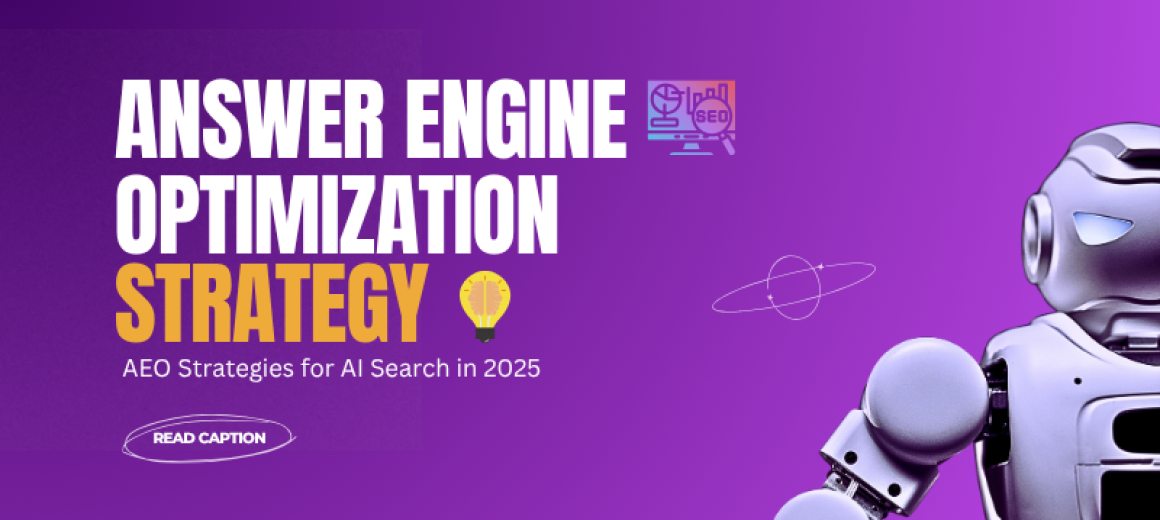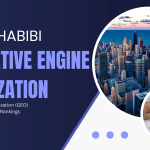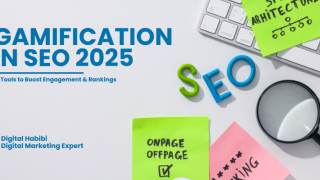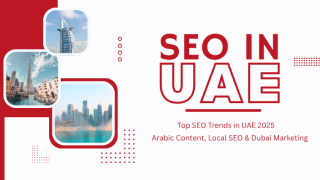Now is the time for one of the most important changes in the history of digital marketing. One type of platform is an answer engine, which doesn’t just show a list of links but instead gives immediate, verbal replies that are full of context. This is how search engines have changed since they were just word matchers. How people get information has changed because of tools like Google’s Search Generative Experience (SGE), Microsoft’s Copilot, and AI-powered assistants like ChatGPT. They’re done looking; they need to know what to do now.
People who are in charge of SEO, content, and growth marketing need to make big changes to the plans that used to work. Answer Engine Optimisation (AEO) is the area that will help your content be picked and shown in AI-made summaries, conversational summaries, and voice helper answers. Traditional SEO is still important, but AEO is the way of the future.
What is Answer Engine Optimization (AEO)?
Answer Engine Optimisation, or AEO, is the process of getting your material ready for software that uses AI to cite, summarise, and give directly to users in answer to their questions. On the first page of Google, you don’t have to fight for blue links. AEO helps you become the source behind the AI’s answer.
Generative Engine Optimisation (GEO), a system made just for generative AI search models, is closely linked to AEO. Traditional SEO is all about rankings, backlinks, and metadata. AEO and GEO, on the other hand, are more about organised clarity, contextual depth, and trust signs that are easy for AI systems to understand.
To understand the difference:
- SEO is all about getting to the top of search results to get people to your site.
- AEO is the process of choosing which of your material to use in AI-made answers, recaps, and overviews.
- Also, key measures are different. You keep an eye on traffic, domain reputation, and keyword placements in SEO. In AEO, you can keep an eye on where answers are placed, how visible snippets are, and how many times individuals use the AI review.
Many industries, including iGaming SEO, online gambling SEO, sports betting SEO, SEO in UAE, and Arabic SEO content marketing, are feeling this change right away because they have to be so competitive. This is an example of how being picked as the trusted AI answer can make or break your exposure.
Content Patterns That Make AI Summaries Work
Before they decide what to show in answers, AI-driven computers look at organisation and clarity. The following content themes work especially well, and they all look best when written in an organised, bullet-pointed way:
- Question-and-Answer Style: AI and search engines match up questions with quick replies. It will be easier for the AI to find and share your content if you write it as questions in normal language and give short, correct replies. People are likely to pick a FAQ that starts with “What are the best SEO strategies for online casinos in 2025?” and then gives a short answer.
- Short explanations and descriptions that are easy to understand: A tone is set by the first line, which should quickly describe an idea. This should be between 30 and 50 words long so AI has a good starting point. Like: “Answer Engine Optimisation (AEO) is the process of organising content in a way that makes it easy for AI-powered search engines like SGE and Copilot to find in their direct answers.” These small pieces can be used over and over in engines.
- Frameworks with numbers and steps: Both people and computers can understand what is written in an ordered list. A title like “5 Steps to Improve Your Sports Betting SEO” makes the plan clear from the start. For better generative recaps, each step should be broken down into a small text that AI can read on its own or in the right order.
- Charts and comparisons Points of view: When complicated thoughts are put into tables, AI models can quickly find comparison logic. You can show AI ordered links that it can use to make answer samples by putting Traditional SEO and AEO next to each other in a two-column table. Every row is a report that has already been made.
- Localised and international content: AI is using these factors more and more when it produces results. You can make sure that your site shows up for answers that are specific to that area by writing in more than one language and including local information, such as Arabic SEO content for SEO in UAE. This way of writing makes your information useful for both the society and the situation.
- Using games in SEO content: Chores, polls, and quizzes are all types of interesting content that keep people on the page longer and show that they are interested. These things are seen as good by AI systems. Something like a test that checks how ready people are to bet on sports Everything can be better with SEO. It can keep people excited and improve your AEO signs at the same time.
- Layered Content Depth: AI systems like both lists and in-depth knowledge. When you use both short description lines and longer explanations, you give search engines a choice of different kinds of information. Because of the way it is stacked, you are more likely to be mentioned in different kinds of questions.
- Discussional Anchors: Writing with natural language like “Here’s why this matters for SEO in Dubai” makes it easier for it to fit into generative answers, which are full of chatty answers. These language bases help you talk to AI in the way it likes best.
Checklist for Technical AEO
To optimise material for answer engines, you also need to know a lot about technology. Here is a thorough list that goes beyond bullet points and tells you “why” each strategy works:
- Markup for Frequently Asked Questions, How-To Guides, and Reviews using Schema: AI tools can better understand context if you mark up your material with structured data. For instance, using FAQ format makes it more likely that your Q&A content will be directly included in AI replies.
- Entity Recognition and Structured Metadata: Use schema markup to label important entities, like “Arabic SEO content,” “Luxury sports betting,” and “Dubai.” AI systems link these things to what users want, which raises your chances of being mentioned.
- Balanced Content Length: Keep a mix between short summaries (so AI can read them quickly) and long-form detail (so people trust you). The best format is a short summary line followed by a 1,500–2,000-word description of each point.
- Crawlability and Indexation: Keep your XML sitemaps clean, fix crawl mistakes, and put Core Web Vitals at the top of your list to make sure your website is easy for crawlers to find. Your attempts to optimise your pages will be useless if AI systems can’t get to them or understand what they say.
- Ready in Multiple Languages and Modes: Arabic SEO content is necessary in places like the UAE. Also, include summaries for audio and video files, as AI uses more and more multimodal material.
- Conversational Query Targeting: Build your content around requests that are asked in normal language. Instead of just searching for “cool trails near me,” try asking something like, “Which are the best cool trails near me for families?”
- Entity Clustering and Content Hubs: Make content groups with the same idea that are linked to each other, like “Ultimate Guide to Online Casino SEO.” This makes specific authority stronger, which is something AI systems value.
AEO Measurement and Reporting
Tracking visibility across AI summaries, analysing engagement signs, and showing business effect through new KPIs that reflect the changing search environment are all parts of reporting on AEO success. The most important factors to keep an eye on are listed below in short points:
- Pages that are getting AI/Overview placements: Finding out which of your web pages show up in AI-driven results like Google’s Search Generative Experience (SGE), Microsoft Copilot summaries, or ChatGPT-style summaries is the first and most important measure. Keeping track of these places helps you figure out what kinds of formats, topics, and patterns get you chosen as a cited source.
- Featured Snippet Count: Featured snippets are still an important part of AEO in 2025. These structured pieces are still used to build a lot of AI results. Based on how many snippets your site has, you can get a good idea of how visible it is in both regular search results and creative AI highlights. When the number of snippets goes up, AEO performance generally gets better.
- CTR (Click-Through Rate) Lift: One problem with AEO is that AI answers can answer questions without getting a click. To fight this, keep an eye on your CTR from content that uses AI and try out hooks that are based on curiosity. People are more likely to click through to solutions that start with “Here’s why most iGaming SEO strategies fail—and how to fix them.”
- Engage Metrics: AI systems use involvement signs to figure out the quality of content. You can learn more about how people interact with your content by keeping track of their stay time, scroll depth, bounce rate, and how they use gamified features. A lot of activity makes you more trustworthy and makes it more likely that AI engines will find your material.
- Local SEO KPIs: Local signs are very important for markets in the UAE or Dubai. Keep track of how many times your Google Business Profile and other local search tools are seen, clicked on, and used. Making Arabic SEO content is also very important, because being able to work with multiple languages improves the chances of being included in AI answers that are tailored to local users.
AEO’s Future in 2025 and Beyond
Answer Engine Optimisation (AEO) is no longer a test strategy; it is now one of the most important parts of modern search strategy. It shapes how brands, industries, and even whole regions will fight for exposure in a world where AI-driven, answer-first search experiences are the norm.
- Change from Queries to Conversations: Search is changing from getting information based on keywords to having constant conversations. Users may not type “sports betting SEO” when they ask, “How can I promote my sports betting site safely in the UAE?” and AI will come up with solutions that make sense in that situation. Businesses need to plan material that can be used in different speaking situations.
- Rise of Multimodal Answers: AI answers will include text, pictures, charts, movies, and even voice explanations. Your business will be a part of more complete answers if you make multimodal material that AI systems can index.
- Personalisation and Trust Signals: E-E-A-T (Experience, Expertise, Authority, Trustworthiness) will be given more weight by AI. Your content will be marked as “safe to cite” by search engines if it has reviews, case studies, and real-life signs like author bios, certifications, and local context.
- Regulation and Openness: There will likely be new rules about how AI quotes sources, especially in touchy areas like gaming, healthcare, or finance. As important as it is to rank well, it will also be important to rank well for trust and respect.
Conclusion
Answer Engine Optimisation (AEO) isn’t just a trendy term; it’s the next big thing in search exposure. As AI-powered engines like Google’s SGE, Microsoft Copilot, and ChatGPT change how people get information, the brands that change with the times will be the ones that people talk about the most. AEO is different from traditional SEO because it focusses on being the trusted voice in AI-powered replies instead of just fighting for clicks.
Businesses can make sure their online presence will still be relevant in the future by using organised content, conversational formatting, international targeting, and strategies that focus on involvement. As 2025 and later years pass, “Will AEO replace SEO?” is no longer a question. but “How quickly will you change to make sure AI answers heed the voice of your brand?”
Frequently Asked Questions (FAQs)
In traditional SEO, the goal is to get better rankings in search results so that links can bring in more visitors. AEO, on the other hand, is all about making material better so that AI-powered engines (like SGE, Copilot, and ChatGPT) can find it as a straight answer. AEO doesn’t just try to get hits; it also makes sure that your brand is the go-to source in chat and summary-based search experiences.
The biggest gains are seen in industries with a lot of competition and a lot of information, like iGaming SEO, sports betting SEO, online gambling SEO, and localised markets like SEO in the UAE or Arabic SEO content marketing. In these areas, being chosen as the AI’s answer can mean the difference between being at the top of the market and being completely invisible.
The best place to start is to reorganise your content so that it is clear and easy for computers to read. Use question-and-answer forms, short explanations, schema markup, and information that is localised. After that, keep an eye on AEO-specific KPIs like AI overview placements, featured snippets, and interaction data. Over time, adding meaning to your content and focussing on conversational anchors will help your brand easily fit with engines that are run by AI.






